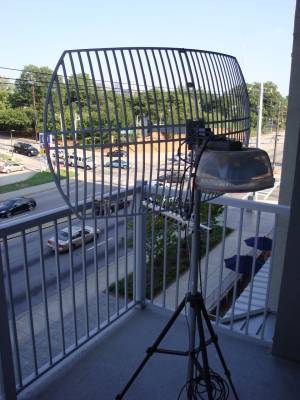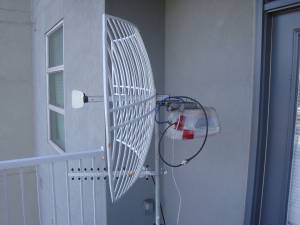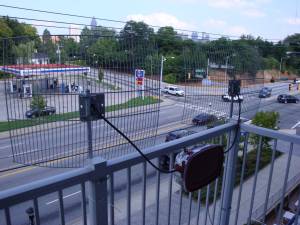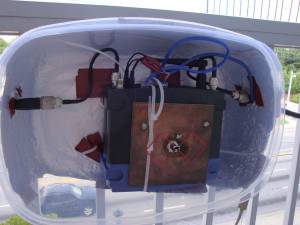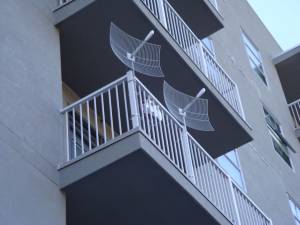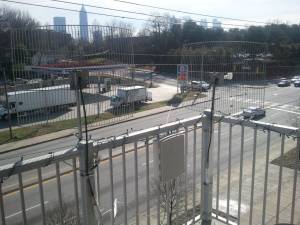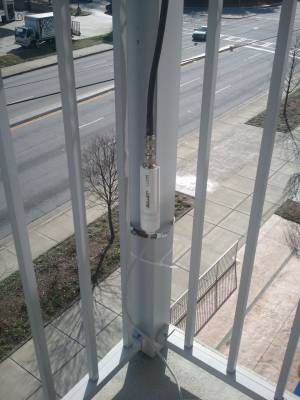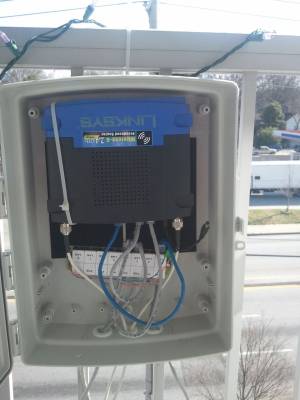Sidebar
Table of Contents
Dual WiFi Antennas and Networking
Although my home-made biquad antenna worked pretty well, I soon learned it wasn't even close to an optimal antenna design. As it turns out, you can just buy directional, high-gain antennas for WiFi (who would have thought?), and they aren't terribly expensive either. Here are a few of my experiments.
First Design - Single Mesh Antenna
The first antenna I tried was an old antenna that used to be used at the radio station I worked at. At some point we had a wi-fi link from our studio to transmitter, but it was struck by lightning. So I got the antenna and mounted it to a pole, and put that on the tripod from my previous antenna. The antenna has 24dB of gain! All of the network settings and hardware were the same (a Linksys WRT54GL running DD-WRT). I managed to mount the router in the same tubberware. The antenna had an N-connector and the router had a RP-TNC connector (RP is reverse polarity, which switches the inside pin. RP connectors are typically used in consumer hardware, while normal connectors are used in commercial hardware). I managed to find a cheap adapter cable on eBay.
This setup worked very well. I had a much stronger signal, and it was easier to align the antenna properly. I used this antenna for several months. (ignore the yagi antenna below the dish, that was another experiment)
Second Design - Dual Mesh Antenna
My friend introduced me to a linux distro called eBox (now called Zentyal). eBox is a small business server distro that has a lot of cool networking features built into it's web GUI, which makes it very easy to manage. One key feature was it's ability to use multiple connections. It's very easy to set up multiple gateways and have it load balance all external traffic between them. So if one antenna works well, why not two?
I found some very cheap mesh antennas on eBay. (Two for $60). I also found that I could mount them on poles on the outside of my balcony railing and tie them down with some metal hose clamps. This made it easier to position them and allowed me to reclaim half of my balcony for sitting. I also got a new tubberware container and put two WRT54GL routers inside of it. I had to modify my cable for my pseudo-PoE, but it worked just fine.
Now, I had a much better network topology. The linux server acted as the main gateway and firewall for my network, and on the WAN side I had each of the WRT54GL's connected to the campus WiFi. I now had two solid connections to campus, and I was free to use one for myself and give one to my roommate, or split it so downloading files went to one antenna and internet/gaming went to another.
Third Design - Two-Way System
Of course, this still wasn't an optimal wireless link. I was using a highly directional system on one end connected to a standard omnidirectional access point in a building a quarter mile away. Ideally, I wanted a directional antennas on each end of the link. But I couldn't get access to the roof of the building nearby, and even if I could put something up there, it would still have to be a wireless relay. But I did have a clear line-of-sight to the WREK tower, and I was the chief engineer… so why not put something up there?
I found some really cool outdoor wireless access points. Ubiquiti Networks makes some really cool products, most notably outdoor WAP's with build-in antennas. They have some cool mesh and dish antennas that have the electronics built in, so you have no feedline loss and much lower risk of electrical problems. I only needed a quarter mile of range, so I got their NanoStation access point, which has a built in patch antenna of about 9dB.
Fortunately, these thoughts coincided with our major FM antenna upgrade, so I was easily able to get up the tower when it was already rigged and the main transmitter was turned off. I had the construction crew that was there help me install the access point with outdoor Cat-5e cable. The other end connected to the local switch and included PoE adapter. The link worked! I now had a full two way link, which has been much more reliable and faster than previous designs.
At my apartment, I upgraded my old Linksys routers to some new Ubiquiti Bullet2 units. These guys are tiny, better for outdoor and use less RF cable (they connect directly to the antenna, no need for an adapter cable). In order to use two and so that I could also maintain a connection to the campus WiFi, I got a new outdoor enclosure and mounted one of the Linksys routers inside to use as a switch. I also got a very hand PoE distribution module on eBay for $20 that helped me connect everything together. In the end, I only need a single ethernet cable running to my patio to power two Bullet's and the Linksys WRT54GL (and I could add more).
Visit from the FBI
Fun story time!
One day during the summer of 2010, I came home from my internship to find a business card on my door. It was from a special agent from the FBI that said “Daniel and [roommate], I need your assistance with a matter. Neither you or your families are in trouble.” How cryptic. I called the agent and he said he wanted to speak to me in person, so I agreed to meet him for lunch. In the mean time, I contacted my friend's dad who also worked for the FBI. I gave him the contact info so that he could look into it. He got back to me and told me that the agent was legit, but couldn't say anything more.
At this point, I still had NO IDEA what this was about, but I wasn't too worried (if the FBI was trying to bust me for something, they wouldn't casually drop by and ask me to call them back at my convenience).
A few days later when I was supposed to meet the agent at Zaxby's for lunch, I got my meal and sat down. When he walked in, he immediately recognized me and came up to me. He showed me his badge, started some small talk and asked what I was doing. I told him I was interning at a satellite communication company nearby and I was working a lot with antennas. That's when he said “… well, that's kind of what I wanted to talk to you about.” At that moment I put it together in my head and said “wait, you're here about my WiFi antennas?” He said yes and I started laughing.
Someone had reported my antennas as suspicious activity. Ha! They wanted to see if I was stealing research data or something. So he just asked me a few questions about how it worked, if it could “change frequencies” (that's not how antennas work), if any foreign nationals were really interested in my project, etc. He even said they didn't care if I was stealing internet (I'm not, I pay my student technology fees!). It ended up being a harmless visit, but still a very amusing story.
Writeup: January 2012

